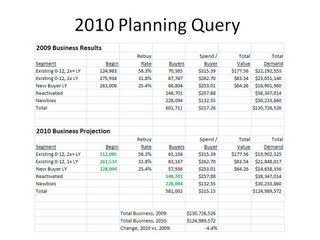Planning: An Overview
Please click on the image to make it bigger.

Annual Sales Planning is a lost art in the e-commerce era. In many cases, this happens because standard web analytics software applications are customized for conversion analysis --- the tools are not designed to answer strategic questions, instead, they are designed to answer important, tactical questions.
In other cases, this happens because nobody is teaching the craft of annual sales planning to a new generation of business leaders.
So let's do some teaching!
It's not terribly hard to construct the queries necessary to analyze the business. Pull all customers who purchased during 2008, and segment them into three groups ... those acquired prior to 2008 who purchased twice, those acquired prior to 2008 who purchased once, those acquired during 2008. Then, pull all customers who purchased during 2009 and not during 2008, split them into two groups --- those who had previously purchased, those who were new in 2009.
You now have five segments. For these five segments, calculate the percentage who purchased in 2009, calculate how much each purchaser spent, and then calculate total demand.
This set of queries yields the top half of the table. We can deconstruct where demand was generated for this $130,000,000 business.
Now, we run the exact same set of queries, but we adjust the date ranges by one year. This gives us the starting number of customers in the three existing customer segments. These three quantities are plugged in to the bottom portion of the table (color = green).
Finally, we have to plug in an estimate for how many reactivated customers we will have, and how many new customers we will have. For the purpose of this table, I assumed that the quantities will be the same as in 2009.
Plugging these values into the spreadsheet, I have a forecast for demand for 2010 ... $124.9 million is the forecast, a demand decline of 4.4%, assuming that everything in 2010 is the same as in 2009.
We'll stop the discussion here, for today. What we know is that, if things go the same way in 2010 as they went in 2009, the business will be 4.4% smaller in 2010. This is a metric that you must know, one that I routinely calculate for CEOs, CMOs, and CFOs.
Labels: Planning
2 Comments:
Thanks Kevin, took me a while to really probe the query paragraph but got it in the end!
Good metric.
Good!
Post a Comment
Links to this post:
Create a Link
<< Home